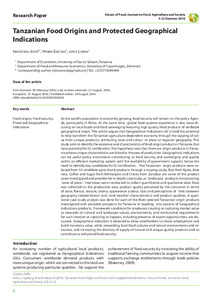| dc.date.accessioned | 2016-09-20T06:26:29Z | |
| dc.date.available | 2016-09-20T06:26:29Z | |
| dc.date.issued | 2016-08-29 | |
| dc.identifier.issn | 2197-411X | |
| dc.identifier.uri | urn:nbn:de:hebis:34-2016050350204 | |
| dc.identifier.uri | http://hdl.handle.net/123456789/2016050350204 | |
| dc.language.iso | eng | |
| dc.publisher | Department of Organic Food Quality and Food Culture at the University of Kassel, Germany and Federation of German Scientists (VDW) | eng |
| dc.rights | Urheberrechtlich geschützt | |
| dc.rights.uri | https://rightsstatements.org/page/InC/1.0/ | |
| dc.subject | Food origins | eng |
| dc.subject | Food security | eng |
| dc.subject | Protected Geographical Indications | eng |
| dc.subject.ddc | 630 | |
| dc.title | Tanzanian Food Origins and Protected Geographical Indications | eng |
| dc.type | Aufsatz | |
| dcterms.abstract | As the world`s population is constantly growing, food security will remain on the policy Agenda, particularly in Africa. At the same time, global food systems experience a new wave focusing on local foods and food sovereignty featuring high quality food products of verifiable geographical origin. This article argues that Geographical Indications (GI´s) hold the potential to help transform the Tanzanian agriculture-dependent economy through the tapping of value from unique products, attributing taste and colour to place or regional geography. This study aims to identify the existence and characteristics of food origin products in Tanzania that have potential for GI certification. The hypothesis was that there are origin products in Tanzania whose unique characteristics are linked to the area of production. Geographical indications can be useful policy instruments contributing to food security and sovereignty and quality within an efficient marketing system with the availability of government support, hence the need to identify key candidates for GI certification. Five Tanzanian origin products were selected from 14 candidate agricultural products through a scoping study. Rice from Kyela, Aloe vera, Coffee and Sugar from Kilimanjaro and Cloves from Zanzibar are some of the product cases investigated and provides for in-depth case study, as ´landscape´ products incorporating ´taste of place´. Interviews were conducted to collect quantitative and qualitative data. Data was collected on the production area, product quality perceived by the consumer in terms of taste, flavour, texture, aroma, appearance (colour, size) and perceptions of links between geography related factors (soil, land weather characteristics) and product qualities. A qualitative case study analysis was done for each of the (five) selected Tanzanian origin products investigated with plausible prospects for Tanzania to leapfrog into exports of Geographical Indications products. Framework conditions for producers creating or capturing market value as stewards of cultural and landscape values, environments, and institutional requirements for such creation or capturing to happen, including presence of export opportunities, are discussed. Geographical indication is believed to allow smallholders to create employment and build monetary value, while stewarding local food cultures and natural environments and resources, and increasing the diversity of supply of natural and unique quality products and so contribute to enhanced food security. | eng |
| dcterms.accessRights | open access | |
| dcterms.bibliographicCitation | In: Future of Food: Journal on Food, Agriculture and Society. Witzenhausen : University of Kassel, Department of Organic Food Quality and Food Culture. - Vol. 4, No. 2 (2016), S. 6 - 12 | |
| dcterms.creator | John, Innocensia | |
| dcterms.creator | Egelyng, Henrik | |
| dcterms.creator | Lokina, Razack | |

